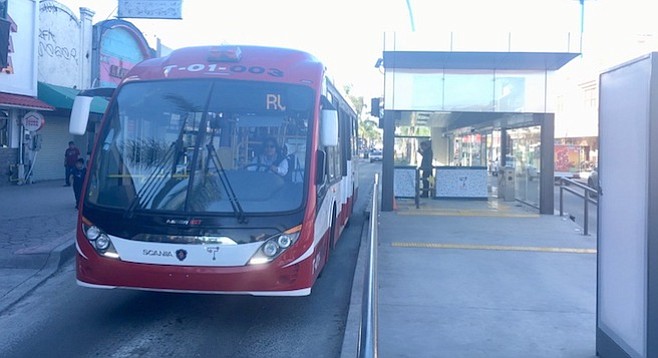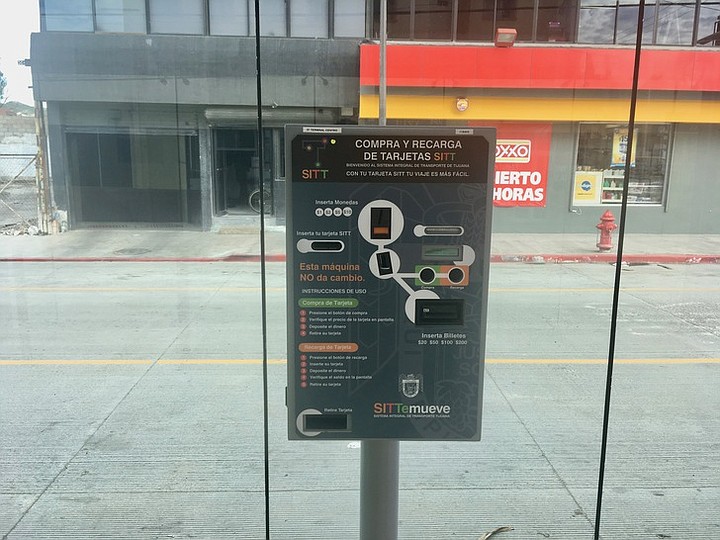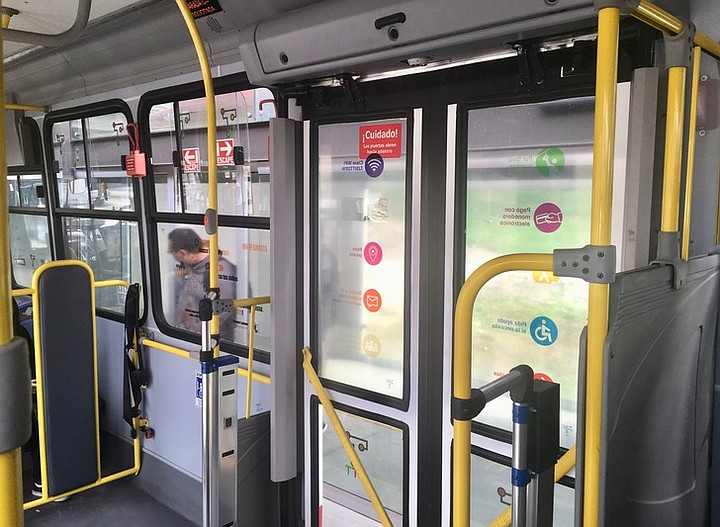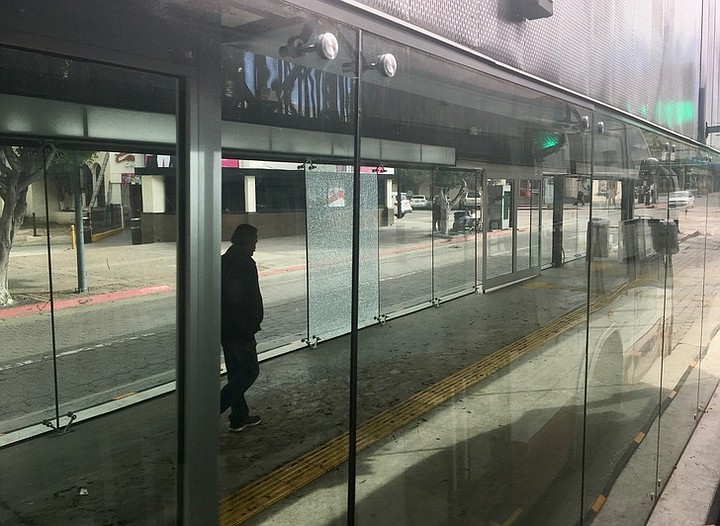 Facebook
Facebook
 X
X
 Instagram
Instagram
 TikTok
TikTok
 Youtube
Youtube

After watching police arrest some minor drug offenders from inside the huge modern bus terminal in the Zone Norte, I headed toward a bus in Tijuana’s new rapid transit system, named SITT (Sistema Integral de Transporte Tijuana).

“There’s no cards yet,” the attendant by the turnstile told me as he saw me trying to figure out the new machine. “They told us that in 15 days or so, but who knows… You have to pay 14 pesos en efectivo [cash]. It doesn’t give change back. It does not accept American coins.” The attendant answered all my questions politely. “The bus will be here in around 12 minutes; it goes by every 20 minutes until 11 at night.”
The bus terminal in Zona Norte was desolate, except for the two attendants and two students sitting on a bench nearby. The terminal extends one big block and has a second level. Several television mounts hang from the ceiling (but with no screens), there are 16 automatic sliding doors (but only one functioning), 30 garbage cans (only 2 with plastic bags and some trash), two unmarked and sizable bathrooms with a single toilet each, a transit-card vending machine (but no cards), and dozens of benches with only three people sitting (myself included).
When SITT was announced last year, the government said it would serve more than 300,000 people a month. It was expected to be serving more than 100,000 people by now. Less than 5000 people have used it each month since it was inaugurated in late November of last year.

The bus for ruta troncal, the main route of the new system, got to the terminal before the 12 minutes were up. The 40-foot Swedish bus (Scania) has double doors on each side in the middle, another door near the driver, 22 seats facing forward, 4 seats near the driver that face backward. There’s space for people to stand, space for bags, as well as a wheelchair ramp and space for a couple of wheelchairs. It has security cameras, is well lit, has clear signs and functioning buttons to request stops. The bus was halfway full. I took the first empty seat I saw by the door.
“Are you touring the city for Pokémon?” asked a student who sat next to me. I told him I was testing the WiFi connection by playing Pokémon Go. The WiFi works, but it's a tad slow and disconnects every other stop.
“The bus is a bit slow, but it’s economic and better than the old calafias,” Adrián, the student, commented on our trip. “The bus from Tecate drops us off near Zona Norte, and from there we go to the Hospital General. We are medical students there. I don’t know Tijuana very well, but I have been riding the [SITT] bus for the past two weeks; all of them have been very clean and none had graffiti.”
The bus goes from the Zona Norte terminal through Avenida Revolución. After two bus stops, it turns east on 8th Street toward Zona Rió. With no stops requested or people waiting at the bus stops, the bus skipped the two stations on 8th Street and entered Zona Rió. Adrián got off on the third stop in Zona Rió, near the Cuauhtemoc statue.
The bus gets out of Zona Rió a few stops from the Cuauhtemoc statue; by the Lincoln statue it turns onto Viá Rápida, Tijuana’s highway parallel to the river. There are eight new pedestrian bridges near completion that connect the bus stops over the river.

The remainder of the ruta troncal trip was mostly on Viá Rápida. The bus skipped every other stop. “Que tengan buen día!” the female driver shouted when passengers got off. One of every four bus stops had shattered plexiglass and/or minimal graffiti. Tijuana’s city government keeps replacing the glass, but the breakage persists.
Since the payment method is not functioning at the bus stops, passengers enter through the middle doors of the bus, walk toward the driver, and insert exact cambio into the machine, a tedious process. There is no receipt or indication that you paid.
After 22 stops and almost an hour on the road, the bus arrived in the other main terminal on Avenida de los Insurgentes, a bit over 11 miles southeast of downtown Tijuana, next to El Cerro Colorado. The other terminal is similar in size to the one in Zona Norte, but it is more active, with a dozen SITT workers, connecting routes that are free of charge, and more passengers. Despite the activity, the terminal’s massive size gives it a desolate appearance.
I waited almost 15 minutes before getting on the same bus to downtown. Since I didn’t exit the terminal, there was no need to pay the 14 pesos again. The other half of the loop is another 22 stops, retracing the same route mostly through Viá Rápida, exiting several times on Avenida de los Insurgentes, including a stop at the old main bus terminal, then through the other side of Zona Rió, stopping by the San Ysidro border before it completes the loop back to Zona Norte.
The whole loop was a bit under two hours and it was a pleasant experience compared to the chaotic, irresponsible, questionable fares, and unreliable public transit in Tijuana.


After watching police arrest some minor drug offenders from inside the huge modern bus terminal in the Zone Norte, I headed toward a bus in Tijuana’s new rapid transit system, named SITT (Sistema Integral de Transporte Tijuana).

“There’s no cards yet,” the attendant by the turnstile told me as he saw me trying to figure out the new machine. “They told us that in 15 days or so, but who knows… You have to pay 14 pesos en efectivo [cash]. It doesn’t give change back. It does not accept American coins.” The attendant answered all my questions politely. “The bus will be here in around 12 minutes; it goes by every 20 minutes until 11 at night.”
The bus terminal in Zona Norte was desolate, except for the two attendants and two students sitting on a bench nearby. The terminal extends one big block and has a second level. Several television mounts hang from the ceiling (but with no screens), there are 16 automatic sliding doors (but only one functioning), 30 garbage cans (only 2 with plastic bags and some trash), two unmarked and sizable bathrooms with a single toilet each, a transit-card vending machine (but no cards), and dozens of benches with only three people sitting (myself included).
When SITT was announced last year, the government said it would serve more than 300,000 people a month. It was expected to be serving more than 100,000 people by now. Less than 5000 people have used it each month since it was inaugurated in late November of last year.

The bus for ruta troncal, the main route of the new system, got to the terminal before the 12 minutes were up. The 40-foot Swedish bus (Scania) has double doors on each side in the middle, another door near the driver, 22 seats facing forward, 4 seats near the driver that face backward. There’s space for people to stand, space for bags, as well as a wheelchair ramp and space for a couple of wheelchairs. It has security cameras, is well lit, has clear signs and functioning buttons to request stops. The bus was halfway full. I took the first empty seat I saw by the door.
“Are you touring the city for Pokémon?” asked a student who sat next to me. I told him I was testing the WiFi connection by playing Pokémon Go. The WiFi works, but it's a tad slow and disconnects every other stop.
“The bus is a bit slow, but it’s economic and better than the old calafias,” Adrián, the student, commented on our trip. “The bus from Tecate drops us off near Zona Norte, and from there we go to the Hospital General. We are medical students there. I don’t know Tijuana very well, but I have been riding the [SITT] bus for the past two weeks; all of them have been very clean and none had graffiti.”
The bus goes from the Zona Norte terminal through Avenida Revolución. After two bus stops, it turns east on 8th Street toward Zona Rió. With no stops requested or people waiting at the bus stops, the bus skipped the two stations on 8th Street and entered Zona Rió. Adrián got off on the third stop in Zona Rió, near the Cuauhtemoc statue.
The bus gets out of Zona Rió a few stops from the Cuauhtemoc statue; by the Lincoln statue it turns onto Viá Rápida, Tijuana’s highway parallel to the river. There are eight new pedestrian bridges near completion that connect the bus stops over the river.

The remainder of the ruta troncal trip was mostly on Viá Rápida. The bus skipped every other stop. “Que tengan buen día!” the female driver shouted when passengers got off. One of every four bus stops had shattered plexiglass and/or minimal graffiti. Tijuana’s city government keeps replacing the glass, but the breakage persists.
Since the payment method is not functioning at the bus stops, passengers enter through the middle doors of the bus, walk toward the driver, and insert exact cambio into the machine, a tedious process. There is no receipt or indication that you paid.
After 22 stops and almost an hour on the road, the bus arrived in the other main terminal on Avenida de los Insurgentes, a bit over 11 miles southeast of downtown Tijuana, next to El Cerro Colorado. The other terminal is similar in size to the one in Zona Norte, but it is more active, with a dozen SITT workers, connecting routes that are free of charge, and more passengers. Despite the activity, the terminal’s massive size gives it a desolate appearance.
I waited almost 15 minutes before getting on the same bus to downtown. Since I didn’t exit the terminal, there was no need to pay the 14 pesos again. The other half of the loop is another 22 stops, retracing the same route mostly through Viá Rápida, exiting several times on Avenida de los Insurgentes, including a stop at the old main bus terminal, then through the other side of Zona Rió, stopping by the San Ysidro border before it completes the loop back to Zona Norte.
The whole loop was a bit under two hours and it was a pleasant experience compared to the chaotic, irresponsible, questionable fares, and unreliable public transit in Tijuana.
Comments